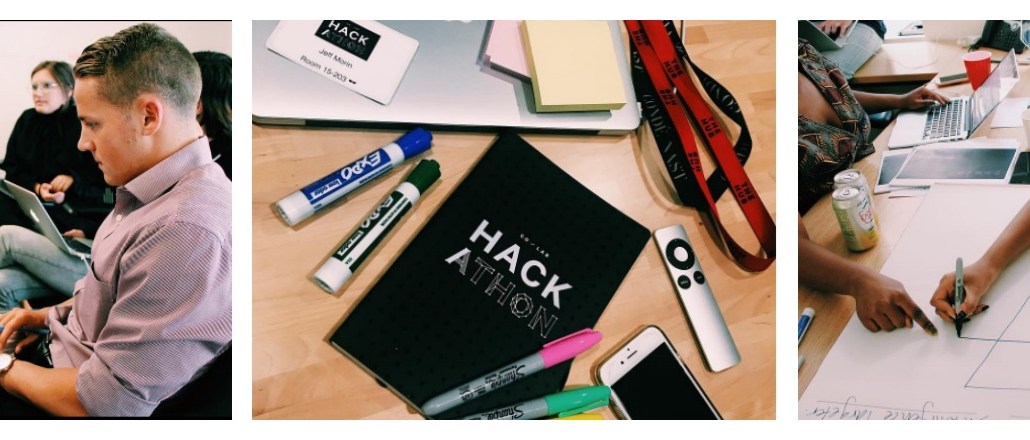Why Conde Nast, with the help of Anna Wintour, is turning to hackathons to innovate


Squirreled away in a glass-enclosed conference room at the Condé Nast Entertainment office on Wednesday, a group of ten employees hailing from different publications and departments were feverishly brainstorming ways to improve e-commerce infrastructure across the media conglomerate’s 20 brands.
A hush fell over the group as Fred Santarpia, Condé Nast’s chief digital officer, walked into the room. A bespectacled Vogue editor wearing a fedora adorned with a feather sat up straighter in his chair. A member of Condé Nast’s product development team apologized for the musky smell and brushed away crumbs from the table, while a sweatshirt-clad engineer to her left minimized his page of coding and turned toward Santarpia.
“Alright, let’s hear your elevator pitch,” Santarpia said, before the team began explaining their idea. The group was part of Condé Nast’s third annual company-wide hackathon, in which more than 300 employees spent three days brainstorming new concepts for the company. The event concluded on Thursday with final presentations in front of a panel of judges that included Vogue editor-in-chief and Condé Nast artistic director Anna Wintour.
The winning team debuted a product called Hopscotch, a bot that functions within the office messaging program Slack. It’s designed to optimize social media sharing across brands, by using trending data and machine learning to inform social strategies. For example, using the bot a Self employee can determine whether a Glamour post would perform well on its Facebook page, and vice-versa.
Hackathons are becoming an increasingly common practice for fashion brands and publications alike, taking a cue from Silicon Valley culture. Though the Condé Nast event catered to all publications — not just its fashion and beauty brands, such as Vogue, Allure and GQ — its impact has been wide-reaching. Last year’s winning team created an API that helps with SEO optimization that is now used by every publication at Condé Nast.
The theme of the hackathon centered on personalization, a vast topic to be sure, but one Santarpia said was intended to prompt teams to think creatively about using data — both external data and information accessible through Condé Nast’s existing APIs. Each team was judged on several categories, which included use of an internal API, overall viability and impact to the company.
“Everything we’re doing is based on data and personalization. We’ve built all these very robust data engineering infrastructures, but education on what those tools are capable of and how they can be used is difficult because data is not anyone’s primary language,” Santarpia said, sitting in his ornate corner office while taking a break from visiting teams. “But taking the time to explain things in a simple and clear way, and asking the teams to use the tools for different purposes in a very consolidated period of time is proving to a be a crash course of what the capabilities are.”
The teams were strategically selected by Arlie Sisson, vp of emerging products at Condé Nast. Her office wall is currently covered in color-coded sticky notes featuring names of employees, which she used to form the teams in an attempt to pair a diverse mix of mindsets and backgrounds, from computer engineers and creatives, to editors and members of the HR team. While the hackathon was open to the entire company, it had a 50-person waitlist due to space issues.
Santarpia, who Condé Nast appointed as its first chief digital officer in 2014, said beyond the benefit of giving employees three unfettered days away from daily responsibilities to think big picture, the hackathon has led to major change for the company.
“We tend to focus so much on urgency — emails, responding to phone calls, putting out fires, notifications on your phone — that we don’t get the chance to clear our minds,” he said. “Being able to take hundreds of people across print, digital, business, editorial, and across every single brand and corporate group, and being able to harness that energy toward a common goal is just an incredibly powerful thing.”
About half of the hackers were new to the event. To account for first-timers, Sisson held a series of pre-hack classes, in part as a means of alleviating anxiety around presenting to notable judges, who in addition to Wintour, included Santarpia, Condé Nast CEO Bob Sauerberg, Conde Nast COO Sahar Elhabashi and Allure editor-in-chief Michelle Lee.
“[Wintour’s] participation is very, very meaningful because she is such a visible leader of the company. To have some of these kids be in a room, judged by Anna, is a wonderful career experience,” Santarpia said.
Toward the end of Wednesday afternoon, Santarpia popped into another conference room, adjacent from the team toiling away on its e-commerce platform. This time, he met a group working on a chatbot for Self, which it plans to expand to all the brands. Phillip Picardi, digital editorial director at Teen Vogue, piped up from where he was sitting in the corner, voicing an additional idea that just came to him.
“I wish I had thought of that,” Santarpia said, leaning forward in his seat. Picardi, unsure if this was sarcasm, cautiously responded, “I’m not sure if you’re kidding and you’ve actually already done this or not.”
“No, I’m being serious. I wish I had thought of that,” he said with a smile, before leaving the room.
More in Media

Publishers are hunting for AI prompt data — now they’re starting to get it from third-party companies
Publishers are finally gaining some visibility into AI search, as new prompt data tools crack open a black box.

Digiday+ Research: Publishers’ growing focus on video doesn’t translate to social platforms
Major publishers have made recent investments in vertical video, but that shift is not carrying over to social media platforms.

Technology x humanity: A conversation with Dayforce’s Amy Capellanti-Wolf
Capellanti-Wolf shared insight on everything from navigating AI adoption and combating burnout to rethinking talent strategies.








